Festo CTEU-CC Handleiding
Festo
Niet gecategoriseerd
CTEU-CC
Bekijk gratis de handleiding van Festo CTEU-CC (4 pagina’s), behorend tot de categorie Niet gecategoriseerd. Deze gids werd als nuttig beoordeeld door 13 mensen en kreeg gemiddeld 4.7 sterren uit 7 reviews. Heb je een vraag over Festo CTEU-CC of wil je andere gebruikers van dit product iets vragen? Stel een vraag
Pagina 1/4

1 Installation
1.1 Allgemeines
Diese Beschreibung enthält Informationen zur Montage
des Busknotens auf einem geeignetem Gerät (z. B.
Ventilinsel) von Festo mit I-Port-Schnittstelle und zur In-
stallation dieser Kombination in einem übergeordneten
Steuerungssystem.
Hinweis
. . . . . . . . . . . . . . . . . . . . . . . . . . . . . . . . . . . . . . . . . . . . . . . . . .
– CC-Link
®
, TORX
®
sind eingetragene Marken der je-
weiligen Markeninhaber in bestimmten Ländern.
1.2 Allgemeine Hinweise
DerindieserBeschreibungdokumentierteBusknoten
CTEU-CCistausschließlichfürdenEinsatzalsTeilnehmer/
Station(Slave)amFeldbusCC-Linkbestimmt.Erdarfnurim
OriginalzustandohneeigenmächtigeVeränderungenund
nurintechnischeinwandfreiemZustandeingesetztwerden.
Der Busknoten ist für den Einsatz im Industriebereich
vorgesehen. Im Wohnbereich müssen evtl. Maßnahmen
zur Funkentstörung getroffen werden.
Zielgruppe dieser Beschreibung sind ausgebildete Fach-
leute der Steuerungs- und Automatisierungstechnik, die
Erfahrungen bei der Installation von Teilnehmern am Feld-
bus CC-Link haben.
Warnung
. . . . . . . . . . . . . . . . . . . . . . . . . . . . . . . . . . . . . . . . . . . . . . . . .
Verletzungsgefahr durch unkontrollierte Bewegungen
angeschlossener Geräte.
Stellen Sie sicher, dass sich Elektrik und Pneumatik in
strom- und drucklosem Zustand befinden.
Vor Arbeiten an der Pneumatik:
• Druckluftversorgung ausschalten
• Ventilinsel entlüften
Vor Arbeiten an der Elektrik, z. B. vor Installations- oder
Instandhaltungsarbeiten:
• Spannungsversorgungen ausschalten
Sie vermeiden damit:
– unkontrollierbare Bewegungen losgelöster Schlauch-
leitungen
– ungewollte und unkontrollierte Bewegungen der an-
geschlossenen Aktorik
– undefinierte Schaltzustände der Elektronik
Hinweis
. . . . . . . . . . . . . . . . . . . . . . . . . . . . . . . . . . . . . . . . . . . . . . . . . .
Der Busknoten enthält elektrostatisch gefährdete Bau-
elemente.
• Berühren Sie keine elektrischen/elektronischen Bau-
elemente.
• Beachten Sie die Handhabungsvorschriften für elek-
trostatisch gefährdete Bauelemente.
Sie vermeiden damit ein Zerstören der Elektronik.
Hinweis
. . . . . . . . . . . . . . . . . . . . . . . . . . . . . . . . . . . . . . . . . . . . . . . . . .
Verwenden Sie einen Festo Feldbusstecker für den An-
schluss an den Feldbus sowie Schutzkappen bzw.
Blindstopfen, um ungenutzte Anschlüsse zu verschlie-
ßen. So erreichen Sie die Schutzart IP65/67.
1.3 Montage
Hinweis
. . . . . . . . . . . . . . . . . . . . . . . . . . . . . . . . . . . . . . . . . . . . . . . . . .
Informationen zur Montage des Busknotens auf der
dezentralen Elektrik-Anschlussplatte, Typ CAPC-..., fin-
den Sie in der Montageanleitung, die der Anschluss-
platte beiliegt.
Zur Montage des Busknotens ist eine Ventilinsel von Festo
mit I-Port-Schnittstelle erforderlich.
1.Prüfen Sie die Dichtungen und Dichtflächen an Bus-
knoten und Ventilinsel.
2.Stecken Sie den Busknoten lagerichtig und ohne zu
verkanten auf die Ventilinsel.
3.DrehenSie diedreiselbstschneidendenSchraubenzu-
nächstmit einemTORX-Schraubendreher (Größe T10)
leichtein.NutzenSieggf.vorhandeneGewindegänge.
4.Drehen Sie die Schrauben mit 1,0 Nm fest.
Busknoten, Typ CTEU-CC . . . . . . . . . . . . . . . . . . . . . . . . . .
2 Anschluss- und Anzeigeelemente
Auf dem Busknoten finden Sie folgende elektrische An-
schluss- und Anzeigeelemente:
1 2 3
4
5
1
DIL-Schaltergruppe 1 (Kap. 5.4)
2DIL-Schaltergruppe 2 (Kap. 5.4)
3Status-LEDs
(Zustandsanzeige und Diagnose Kap. 6)
4Spannungsversorgung für Busknoten und ggf. ange-
schlossene Devices (z. B. Ventilinsel) (Kap. 3)
5Feldbusanschluss (D-Sub-Stecker, Kap. 4)
3 Spannungsversorgung
Der Busknoten verfügt über getrennte Signal- und Last-
spannungsversorgungen. Er versorgt auch die über die
I-Port-Schnittstelle angeschlossenen Geräte (Devices) mit
Spannung.
Hinweis
. . . . . . . . . . . . . . . . . . . . . . . . . . . . . . . . . . . . . . . . . . . . . . . . . .
• Verwenden Sie für die elektrische Versorgung aus-
schließlich PELV-Stromkreise nach EN 60204-1 (Pro-
tective Extra-Low Voltage, PELV). Berücksichtigen Sie
zusätzlich die allgemeinen Anforderungen an PELV-
Stromkreise gemäß der EN 60204-1.
• Verwenden Sie ausschließlich Stromquellen, die eine
sichere elektrische Trennung der Betriebsspannung
nach EN 60204-1 gewährleisten.
• Schließen Sie die Stromkreise für Signal- und Last-
spannungsversorgung grundsätzlich beide an.
Durch die Verwendung von PELV-Stromkreisen wird der
Schutz gegen elektrischen Schlag (Schutz gegen direktes
und indirektes Berühren) nach EN 60204-1 sichergestellt.
Spannungsversorgungs-
anschluss (M12, A-codiert)
Pin Belegung
1 24 V PS (Elektronik)
2 24 V PL (Last)
3 0 V PS (Elektronik)
4 0 V PL (Last)
5 FE
1)
1) Anschluss an Funktionserde muss über das angeschlossene Gerät
bzw. die Elektrik-Anschlussplatte (Typ CAPC-…) sichergestellt
werden.
Verwenden Sie zum Anschluss an Netzteile bzw.
Spannungsversorgungen Kabel mit M12-Buchse, A-co-
diert, EN 61076-2-101 (Zubehör www.festo.com/
catalogue).
Die “PS”-LED leuchtet grün, wenn die Spannungsversor-
gung an beiden Stromkreisen korrekt anliegt. Die LED X1
bzw. X2 leuchtet grün, wenn ein Device angeschlossen ist
(Kap. 6).
4 Anschließen des Feldbusses
Hinweis
. . . . . . . . . . . . . . . . . . . . . . . . . . . . . . . . . . . . . . . . . . . . . . . . . .
Bei fehlerhafter Installation und hohen Übertragungs-
raten können Datenübertragungsfehler durch Signal-
reflexionen und Signaldämpfungen auftreten.
• Verwenden Sie grundsätzlich an beiden Enden des
Feldbusses einen Abschlusswiderstand (110 Ω,
0,5 W) entsprechend der CC-Link-Spezifikation.
• Beachten Sie die Spezifikationen Ihres übergeordne-
ten Steuerungssystems bezüglich Kabeltyp, verwend-
barer T-Adapter und max. Länge der Stichleitungen
bzw Abzweigungen.
• Verbinden Sie die Schirmung durchgehend an allen
Feldbuskabeln und erden Sie die Schirmung an je-
dem Gerät.
• Berücksichtigen Sie bei der Berechnung der max.
zulässigen Länge des Feldbuskabels abhängig von
der genutzten Baudrate auch die Summe der Länge
der Stichleitungen und Abzweigungen.
D-Sub-Stecker am Busknoten
FürdasAnschließendesBusknotensandenFeldbusbe-
findetsichaufdemBusknoteneine9-poligeD-Sub-Buchse.
D-Sub-Buchse
Pin Signalan-
schluss
Beschreibung
1 n.c. nicht angeschlossen
2 DA Data A
3 DG Data Ground
(Datenbezugspotential)
4 n.c. nicht angeschlossen
5 n.c. nicht angeschlossen
6 n.c. nicht angeschlossen
7 DB Data B
8 n.c. nicht angeschlossen
9 n.c. nicht angeschlossen
Gehäuse
Kabelschirmung, Ver-
bindung zur Funktions-
erde FE
Feldbuskabel/-leitung
Für die Feldbuskommunikation empfiehlt Festo die
Verwendung verdrillter und geschirmter Leitungen.
• Verwenden Sie mindestens eine geschirmte 3-Draht-
leitung nach CC-Link-Spezifikation.
• Schließen Sie die Schirmung des Feldbuskabels am
Feldbusstecker an.
. . . . . . . . . . . . . . . . . . . . . . . . . . . . . . . . . . . . . . . . . . . . . . .
Baudraten
Einstellbare
Baudrate
[kBd]
DIL-Schalter-Stellung
1)
Max.
Leitungs-
länge
2)
[m]
7 8 9
156 1 200OFF OFF OFF
625 900ON OFF OFF
2 500 OFF ON OFF 400
5 000 160ON ON OFF
10 000 (default) 100OFF OFF ON
1)
Einstellen der DIL-Schalter (siehe Kap. 5.4). Nicht dargestellte
Schalterstellungs-Kombinationen sind unzulässig!
2)
Gesamtlänge aller Leitungen einschließlich Stichleitungen und
Abzweigungen (ohne Einsatz von Repeatern)
Feldbusanschluss von Festo
Zum einfachen Anschluss des Feldbusknotens kann ein
Feldbusanschluss mit Klemmleiste von Festo (Typ
FBA-1-KL-5POL) verwendet werden. Erreichbare Schutz-
klasse: IP20.
Anschluss-Block
Pin Belegung
Anschluss-Block
Typ FBA-1-KL-5POL
FG Funktionserde
SLD Kabelschirm
DG Data Ground
(Datenbezugspotential)
DB Data B
DA Data A
Feldbusstecker von Festo
Mit einem Feldbusstecker von Festo (Typ FBS-SUB-9-GS-
2x4POL-B) kann der Busknoten vom Feldbus getrennt
werden, ohne die Kommunikation der anderen Geräte im
Feldbus zu unterbrechen. Erreichbare Schutzklasse:
IP65/67 (bei Verschluss aller Anschlüsse).
Feldbusstecker
Pin Belegung
Feldbusstecker
Typ FBS-SUB-9-GS-2X4POL-B
DA Data A
DB Data B
DG Data Ground
(Datenbezugspotential)
*NC* nicht angeschlossen
FE Über den Klemmbügel mit
dem Gehäuse des D-Sub-
Steckers verbunden
5 Inbetriebnahme
5.1 Adressierung
Die Adressierung kann wahlweise im Bit- oder im Wortbe-
reich erfolgen. Die Anzahl der belegten Stationen wird
vom Feldbusknoten automatisch ermittelt.
– Im Bit-Bereich entspricht 1 Station jeweils 32 Bit Ein-
gangs- und Ausgangsadressen.
– Im Wort-Bereich entspricht 1 Station jeweils 4 Wörtern
(1 Wort = 2 Byte) Eingangs- und Ausgangsadressen.
– In den ersten 2 Eingangs-Bytes des nicht verwendeten
Bereichs steht das Diagnosewort (sofern die Diagnose
aktiviert ist).
– Durch Setzen von Bit 0 des ersten Ausgangs-Bytes im
ungenutzten Bereich kann die Diagnose-Funktion ak-
tiviert bzw. deaktiviert werden.
– Die jeweils letztes 2 Bytes des Bit-Bereichs sind
reserviert. Bit 11 des Eingangsbereichs enthält das „Re-
mote Ready“-Bit (RR). Das Bit hat bei funktionierender
Kommunikation mit dem Feldbus den Wert „1“.
Daraus ergeben sich folgende Zuordnungen:
Benötigte
Stationen
Verfügbare E/As im
Bit-Bereich Wort-Bereich
1 Station Bis zu 16 E/As
(1…2 Byte)
Bis zu 64 E/As
(1…8 Byte)
2 Stationen Bis zu 48 E/As
(3…6 Byte)
Bis zu 128 E/As
(9…16 Byte)
3 Stationen Bis zu 80 E/As
(7…10 Byte)
–
4 Stationen Bis zu 112 E/As
(11…14 Byte)
–
Hinweis
. . . . . . . . . . . . . . . . . . . . . . . . . . . . . . . . . . . . . . . . . . . . . . . . . .
Bei mehr als 112 E/As wird automatisch der Wort-Be-
reich verwendet.
Beispiel:
Aufteilung von 2 Stationen, Adressierung im Bit-Bereich.
Bit-Bereich
Eingänge (RX) Ausgänge (RY)
Station 1 E15 … E0
Byte 1 … 0 Byte 1 … 0A15 … A0
E31 … E16 Byte 3 … 2 Byte 3 … 2A31 … A16
Station 2 E47 … E32 Byte 5 … 4 Byte 5 … 4A47 … A32
Bit 11 = RR Byte 7 … 6 –reserviert– Byte 7 … 6
Wort-Bereich
Eingänge (RWr) Ausgänge (RWw)
Station 1 Diagnose-Wort
Wort 0 Wort 0Bit0 = Diag. on/off
–reserviert– –reserviert–Wort 1 Wort 1
–reserviert– –reserviert–Wort 2 Wort 2
–reserviert– –reserviert–Wort 3 Wort 3
Station 2 –reserviert– –reserviert–Wort 4 Wort 4
–reserviert– –reserviert–Wort 5 Wort 5
–reserviert– –reserviert–Wort 6 Wort 6
–reserviert– –reserviert–Wort 7 Wort 7
de. . . . . . . . . . . . . . . . . . . . . . . . . . . . . . . . . . . . . . . . . . . . .
Beispiel:
Aufteilung von2 Stationen,Adressierungim Wort-Bereich.
Bit-Bereich
Eingänge (RX) Ausgänge (RY)
Station 1 Diagnose-Wort
Byte 1 … 0 Bit0 = Diag.
on/off
Byte 1 … 0
–reserviert– –reserviert–Byte 3 … 2 Byte 3 … 2
Station 2 –reserviert– –reserviert–Byte 5 … 4 Byte 5 … 4
Bit 11 = RR Byte 7 … 6 Byte 7 … 6–reserviert–
Wort-Bereich
Eingänge (RWr) Ausgänge (RWw)
Station 1 E15 … E0
Wort 0 Wort 0A15 … A0
E31 … E16 Wort 1 Wort 1A31 … A16
E47 … E32 Wort 2 Wort 2A47 … A32
E63 … E48 Wort 3 Wort 3A63 … A48
Station 2 E79 … E64 Wort 4 Wort 4A79 … A64
E95 … E80 Wort 5 Wort 5A95 … A80
E111 … E96 Wort 6 Wort 6A111 … A96
E127 … E112 Wort 7 Wort 7A127 … A112
5.2 Fail state
Fail state regelt das Verhalten des Busknotens und der
angeschlossenen Devices bei Kommunikationsfehlern.
– Hold laste state
Bei einem Fehler in der Kommunikation bleibt der letzte
Status erhalten.
– Reset (default)
Bei einem Fehler in der Kommunikation wird der Status
zurückgesetzt.
5.3 Demontieren der DIL-Schalter-Abdeckung
Zum Einstellen des Busknotens muss die Abdeckung der
DIL-Schalter demontiert werden:
1.Schalten Sie die Spannungsversorgung aus.
2.Drehen Sie die beiden Befestigungsschrauben der
transparenten Abdeckung heraus und entfernen Sie die
Abdeckung.
5.4 Einstellen der DIL-Schalter
Mit den DIL-Schaltern stellen Sie die folgenden Parameter
für den Busknoten ein.
Hinweis
. . . . . . . . . . . . . . . . . . . . . . . . . . . . . . . . . . . . . . . . . . . . . . . . . .
Die DIL-Schalter werden nur beim Start des Bus-
knotens bzw. des Devices abgefragt. Anschließende
Veränderungen der Schalterstellungen werden erst
beim nächsten Start berücksichtigt.
1
2
4 5
3
Pos. DIL-Schalter
1)
Funktion
ON OFF
DIL-Schaltergruppe 1:
11 ... 6: Stationsnummer (1 … 64), binär codiert (Adresse ist
der eingestellte Binärwert +1, „0“ ist nicht einstellbar)
Default: Stationsnummer 1 (Schalter 1 … 6 „OFF“)
DIL-Schaltergruppe 2:
27 … 9: Baudrate Feldbuskabel/-leitung
310: Adressierungs-
bereich
Wortbereich Bit-Bereich
(default)
411 reserviert
512: Fail state Hold last state Reset (default)
1) Schalterstellung “ON” = EIN (Schalter steht oben)
Schalterstellung “OFF” = AUS (Schalter steht unten)
Gehen Sie folgendermaßen vor:
1.Weisen Sie dem Busknoten eine noch nicht belegte Sta-
tionsnummer zu.
2.Stellen Sie die Baudrate ein.
3.Stellen Sie den Fail state-Modus ein.
Die “RUN”-LED leuchtet grün bei fehlerfreier Kommunika-
tion zur SPS (Kap. 6).
Beispiele eingestellter Stationsnummern (Binärwert +1)
Eingestellter Binärwert 5,
entspricht Stations-
nummer: 06 (5+1)
Eingestellter Binärwer 38,
entspricht Stations-
nummer: 39 (38+1)
1 2 3 4 5 6
1
1 2 3 4 5 6
1
5.5 Montieren der DIL-Schalter-Abdeckung
1.Setzen Sie die Abdeckung vorsichtig auf den Bus-
knoten. Achten Sie auf die korrekte Lage der Dichtung!
2.Drehen Sie die beiden Befestigungsschrauben erst
handfest und dann mit max. 0,4 Nm fest.
Uni
v
erseller Busknoten
CTEU-CC
Beschreibung
Busknoten, Typ CTEU-CC
Feldbusprotokoll CC-Link
Original: de
CTEU-CC-D2
8004836
Festo SE & Co. KG
Postfach
D-73726 Esslingen
+49/711/347-0
www.festo.com
de 1206NH

Busknoten, Typ CTEU-CC . . . . . . . . . . . . . . . . . . . . . . . . . .
6 Diagnose
6.1 Diagnosewort/Diagnose über den Feldbus
Das 2 Byte lange Diagnosewort (Adressierung) kann im
Fehlerfall zur Ermittlung der Fehlerquelle ausgewertet
werden.
Hinweis
. . . . . . . . . . . . . . . . . . . . . . . . . . . . . . . . . . . . . . . . . . . . . . . . . .
Die Diagnosefunktion ist nur verfügbar, wenn sie durch
Setzen von Bit 0 des ersten Ausgangs-Bytes im unge-
nutzten Bereich auf „1“ aktiviert wurde.
Bit
Fehler Event-Code
0 Konfigurationsfehler (kein I-Port Device ange-
schlossen)
–
1 –Unterspannung Elektronikversorgung
2 Kurzschluss I-Port Verbindungsleitung –
3 reserviert –
4 reserviert –
5 reserviert –
6 reserviert –
7 reserviert –
8 I-Port 1 Kom.-fehler (Verbindung getrennt) –
9 I-Port 2 Kom.-fehler (Verbindung getrennt) –
10 0x7710I-Port 1 Kurzschluss
11 0x7710I-Port 2 Kurzschluss
12 I-Port 1
Signalspannung PS zu hoch 0x5110
Signalspannung PS zu niedrig 0x5111
Fehler in Lastspannung PL
1)
0x5112
Lastspannung PL zu niedrig
1)
0x5114
13 I-Port 2
Signalspannung PS zu hoch 0x5110
Signalspannung PS zu niedrig 0x5111
Fehler in Lastspannung PL
1)
0x5112
Lastspannung PL zu niedrig
1)
0x5114
14 I-Port 1 sonstige Diagnose
Sonstiger
Event-Code
15 I-Port 2 sonstige Diagnose
1) Nur relevant wenn die PL-Überwachung im Device aktiv ist.
6.2 Zustandsanzeige/Diagnose über LEDs
PS (Power System) - Elektronikversorgung
LED-
Anzeige
Zustand u. Bedeutung
LED leuchtet grün:
– normaler Betriebszustand.
– Signalspannung liegt an (im zugelassenen Bereich).
– Lastspannung liegt an
1)
(im zugelassenen Bereich).
LED blinkt grün
– Elektronikversorgung liegt unterhalb der erforderli-
chen Spannung
– Lastversorgung liegt unterhalb der erforderlichen
Spannung
1)
LED ist aus:
– Signalspannung liegt nicht an oder ist zu gering
1) Anzeige ist abhängig davon, ob das angeschlossenem Device die
Lastspannung überwacht und an das CTEU meldet.
X1 bzw. X2
1)
- Interne Kommunikation zwischen Bus-
knoten und I-Port Device 1 bzw. 2
1)
LED-
Anzeige
Zustand u. Bedeutung
LED leuchtet grün:
– normaler Betriebszustand.
LED blinkt grün:
– Diagnosedaten liegen vor.
Genauere Diagnose Kap. 6.1
LED leuchtet rot:
– Device ist am Busknoten angeschlossen, aber Kom-
munikation ist gestört.
– Das I-Port Device wurde vom Busknoten getrennt.
Genauere Diagnose Kap. 6.1
LED blinkt rot:
– Fehler im Busmodul
– Nach der Inbetriebnahme wurde ein falsches Device
angeschlossen.
Genauere Diagnose Kap. 6.1
Beide LEDs (X1 und X2) blinken rot:
– An keinem der I-Ports wurde ein Device erkannt.
2)
LED ist aus:
– Verbindung wird gerade aufgebaut.
– An keinem der I-Ports wurde ein Device erkannt.
2)
1)
Separates Zubehör mit zwei Schnittstellen zum Anschluss eines
weiteren Devices erforderlich.
2)
Für die Inbetriebnahme des Busknotens ist mindestens ein ange-
schlossenes Device erforderlich.
RUN (Feldbuskommunikation OK)
LED-
Anzeige
Zustand u. Bedeutung
LED leuchtet grün:
– Feldbuskommunikation in Ordnung.
LED ist aus:
– Keine Kommunikation mit dem Feldbusmaster mög-
lich.
Fehlerbeseitigung:
• Prüfen Sie die Feldbusverkabelung mit der überge-
ordneten Steuerung.
• Prüfen Sie die Kommunikationsparameter (Einstel-
lung der DIL-Schalter) sowie die Einstellungen in der
übergeordneten Steuerung.
1)
1)
Stellen Sie die Stationsgröße in der Steuerung auf „4“. Anhand
der Position des „Remote Ready“-Bits kann die benötigte Sta-
tionsgröße ermittelt werden Kap. 5.1
Err (Feldbuskommunkation gestört)
LED-
Anzeige
Zustand u. Bedeutung
LED blinkt rot:
– CRC-Fehler während der Kommunikation.
Fehlerbeseitigung:
• Prüfen Sie die Feldbusverkabelung, insbesondere
den Busabschluss und die Schirmung.
de. . . . . . . . . . . . . . . . . . . . . . . . . . . . . . . . . . . . . . . . . . . . .
7 Technische Daten
Allgemein
Temperaturbereich
– Lagerung/Transport
– Umgebung, Betrieb
-20 ... +70 °C
-5 ... +50 °C
Relative Luftfeuchtigkeit 93%,nicht kondensierend,40°C
Schutzart (nach EN 60529) IP65/67
1) 2)
Schutz gegen elektrischen Schlag Schutz gegen direktes und indi-
rektes Berühren nach EN 60204-1
durch PELV-Netzteil (Protected
Extra-Low Voltage)
Elektromagnetische Verträglich-
keit (Industrie)
siehe Konformitätserklärung
(www.festo.com)
Schwingung und Schock (nach
DIN/IEC 68/EN 60 068
– Schwingung (Teil 2 – 6)
– Schock (Teil 2 – 27)
– Dauerschockfestigkeit (Teil 2 –
29)
Schärfegrad (SG) bei Montage an
Wand: SG 2, Hutschiene: SG 1
Wand: SG 2, Hutschiene: SG 1
Wand und Hutschiene: SG 1
Abmessungen (B x L x H) 40 mm x 91 mm x 50 mm
Gewicht (Busknoten ohne Kabel
und Device)
90 g
Werkstoffe
– Gehäuse
– Lichtleiter,
Abdeckung DIL-Schalter
– Gewindehülse M12
– Gewindebuchse M3
– Dichtungen
– Schrauben
RoHS-konform
PA, verstärkt
PC
Messing, galvanisch vernickelt
Messing
NBR
Stahl, verzinkt
Korrosionsschutz KBK 2
1) Voraussetzung: Busknoten komplett montiert, Steckverbinder im
gesteckten Zustand oder mit Schutzkappe versehen.
2) Beachten Sie, dass angeschlossene Devices u.U. nur eine
geringere Schutzart, einen geringeren Temperaturbereich, etc.
erfüllen.
Betriebsspannungsversorgung
Betriebsspannung Feldbus-Schnittstelle
1)
– Signalspannung
(Nennwert, verpolungssicher)
– Lastspannung (Bereich)
DC 24 V (18 … 30 V)
DC (18 … 30 V)
2)
Eigenstromaufnahme
– Busknoten Elektronik
typ. 70 mA
Stromaufnahme (Summenstrom) für Signal-
und Lastspannungsversorgung
max. 4 A
Galvanische Trennung Busschnittstelle
1) Für Signal- u. Lastspannung ist externe Sicherung erforderlich.
2) Abhängig vom angeschlossenen Gerät (z. B. Ventile)
Hinweis
. . . . . . . . . . . . . . . . . . . . . . . . . . . . . . . . . . . . . . . . . . . . . . . . . .
Technische Daten der angeschlossenen Geräte finden
Sie in den jeweiligen Produktdokumentationen.

1 Installation
1.1 General remarks
This description contains information for mounting the
Busknoten on an appropriate device (e.g. valve terminal)
from Festo with I-port interface and for installation of this
combination in a higher-level control system.
Note. . . . . . . . . . . . . . . . . . . . . . . . . . . . . . . . . . .
– CC-Link
®
, TORX
®
are registered trademarks of the
respective trademark owners in certain countries.
1.2 General instructions
ThebusnodeCTEU-CCdocumentedinthisdescriptionhas
beendesignedexclusivelyforuse asaparticipant/station
(slave)onthefieldbusCC-Link.Itmayonlybeusedinits
originalstatuswithoutunauthorisedmodificationsand
onlyinperfecttechnicalcondition.
The bus node is intended for use in an industrial environ-
ment. Measures for interference suppression may need to
be implemented in residential areas.
The target group of this description consists of trained
specialists in control and automation technology who
have experience with installation of stations on the
CC-Link fieldbus.
Warning. . . . . . . . . . . . . . . . . . . . . . . . . . . . . . . .
Danger of injury through uncontrolled movements of
connected equipment.
Make sure that electrical and pneumatic equipment are
in a de-energised and pressureless status.
Before working on the pneumatics:
• Switch off the compressed air supply
• Vent the valve terminal
Before working on the electrical components,
e.g. before installation or maintenance work:
• Switch off power supply
In this way, you can avoid:
– uncontrolled movements of loose tubing
– accidental and uncontrolled movements of the
connected actuators
– undefined switching states of the electronics
Note. . . . . . . . . . . . . . . . . . . . . . . . . . . . . . . . . . .
The bus node includes electrostatically sensitive
devices.
• Do not touch any electrical/electronic components.
• Observe the handling specifications for electrostati-
cally sensitive devices.
They will help you avoid damage to the electronics.
Note. . . . . . . . . . . . . . . . . . . . . . . . . . . . . . . . . . .
Use a Festo fieldbus plug for connection to the fieldbus
as well as protective caps or blanking plugs to seal un-
used connections. You will then comply with protection
class IP65/IP67.
1.3 Mounting
Note. . . . . . . . . . . . . . . . . . . . . . . . . . . . . . . . . . .
Information on mounting the bus node on the de-
centralised electrical connection box type CAPC-... can
be found in the assembly instructions that accompany
the sub-base.
For mounting the bus node, a valve terminal from Festo
with I-port interface is required.
1.Inspect the seals and sealing surfaces on bus node and
valve terminal.
2.Plug the bus node onto the valve terminal in the right
position and without tilting.
3.First, lightlyscrew inthe three self-tappingscrews witha
Torxscrewdriver(size T10). Useexisting threads, if
available.
4.Tighten the screws with 1.0 Nm.
Bus node, type CTEU-CC . . . . . . . . . . . . . . . . . . . . . . . . . .
2 Connection and display components
The following electrical connection and display
components can be found on the bus node:
1 2 3
4
5
1
DIL switch group 1 (chap. 5.4)
2DIL switch group 2 (chap. 5.4)
3Status LEDs
(status display and diagnostics chap. 6)
4Power supply for bus node and connected devices, if
applicable (e.g. valve terminal) (chap. 3)
5Fieldbus connection (D-sub plug, chap. 4)
3 Power supply
The bus node has separate signal and load voltage sup-
plies. It also supplies voltage to the equipment (devices)
connected through the I-port interface.
Note. . . . . . . . . . . . . . . . . . . . . . . . . . . . . . . . . . .
• Use only PELV circuits for the electrical power supply
in accordance with EN 60204-1 (Protective Extra-Low
Voltage, PELV). Also take into account the general
requirements for PELV circuits in accordance with
EN 60204-1.
• Only use power sources which guarantee reliable
electrical isolation of the operating voltage in ac-
cordance with EN 60204-1.
• Always connect both circuits for signal and load vol-
tage supply.
Through the use of PELV circuits, protection against elec-
tric shock (protection against direct and indirect contact)
is ensured in accordance with EN 60204-1.
Power supply connection
(M12, A-coded)
Pin Allocation
1 24 V PS (electronics)
2 24 V PL (load)
3 0 V PS (electronics)
4 0 V PL (load)
5 FU
1)
1) Connection to functional earth must be ensured through the
connected device or the electrical connection box (type CAPC-…).
For connection to power supply units or power supplies,
use cable with M12 socket, A-coded, EN 61076-2-101
(accessories www.festo.com/catalogue).
The “PS” LED is illuminated green if power supply is cor-
rectly connected to both circuits. The LED X1 or X2 is lit
green if a device is connected (chap. 6).
4 Connecting the fieldbus
Note. . . . . . . . . . . . . . . . . . . . . . . . . . . . . . . . . . .
Faulty installation and high transmission rates may
cause data transmission errors as a result of signal
reflections and attenuations.
• Always use a terminating resistor (110 Ω, 0.5 W) at
both ends of the fieldbus corresponding to the CC-
Link specification.
• Observe the specifications of your higher-level con-
trol system regarding cable type, usable T-adapters
and max. length of branch lines or branches.
• Connect the screening continuously to all fieldbus
cables and earth the screening to each device.
• In calculating the max. permissible length of the
fieldbus cable dependent on the baud rate used, also
consider the sum of the length of the branch lines
and branches.
D-sub plug at the bus node
There isa9-pinD-subsocket onthebusnodeforconnecting
the busnodetothefieldbus.
D-sub socket
Pin Signal
connection
Description
1 n.c. not connected
2 DA Data A
3 DG Data ground
(data reference
potential)
4 n.c. not connected
5 n.c. not connected
6 n.c. not connected
7 DB Data B
8 n.c. not connected
9 n.c. not connected
Housing
Cable screening,
connection to
functional earth FE
Fieldbus cable/line
For fieldbus communication, Festo recommends the use
of twisted and screened cables.
• Use at least one screened 3-core cable in accordance
with CC-Link specification.
• Connect the screening of the fieldbus cable to the
fieldbus plug.
. . . . . . . . . . . . . . . . . . . . . . . . . . . . . . . . . . . . . . . . . . . . . . .
Baud rates
Adjustable
baud rate
[kBd]
DIL switch position
1)
Max. cable
length
2)
[m]
7 8 9
156 1 200OFF OFF OFF
625 900ON OFF OFF
2 500 OFF ON OFF 400
5 000 160ON ON OFF
10 000 (default) 100OFF OFF ON
1)
Setting the DIL switches (see chap. 5.4). Switch position combina-
tions that are not presented are impermissible!
2)
Overall length of all lines, including branch lines and branches
(without use of repeaters)
Fieldbus connection from Festo
For simple connection of the fieldbus node, a fieldbus
connection with terminal strip from Festo (type
FBA-1-KL-5POL) can be used. Achievable protection class:
IP20.
Sub-base
Pin Allocation
Sub-base
type FBA-1-KL-5POL
FG Functional earth
SLD Cable screening
DG Data ground
(data reference potential)
DB Data B
DA Data A
Fieldbus plug from Festo
With a fieldbus plug from Festo (type
FBS-SUB-9-GS-2x4POL-B), the bus node can be
disconnected from the fieldbus without interrupting the
communication of the other devices in the fieldbus.
Achievable protection class: IP65/67 (with plugging of all
connections).
Fieldbus plug
Pin Allocation
Fieldbus plug
type FBS-SUB-9-GS-2X4POL-B
DA Data A
DB Data B
DG Data ground
(data reference potential)
*NC* not connected
FE Connected to the housing of
the D-sub plug through the
clamp strap
5 Commissioning
5.1 Addressing
Addressing can take place optionally in the bit or word
range. The number of stations occupied is automatically
determined by the fieldbus node.
– In the bit range, 1 station corresponds in each case to
32 bits of input and output addresses.
– In the word range, 1 station corresponds in each case to
4 words (1 word = 2 bytes) of input and output
addresses.
– The diagnostic word is in the first 2 input bytes of the
unused range (if the diagnostics are activated).
– The diagnostics function can be activated or deac-
tivated by setting bit 0 of the first output byte in the
unused range.
– The respective last 2 bytes of the bit range are
reserved. Bit 11 of the input section includes the “re-
mote ready” bit (RR). With functioning communication
with the fieldbus, the bit has the value “1”.
This results in the following assignments:
Required
stations
Available I/Os in the
Bit range Word range
1 station Up to 16 I/Os
(1 … 2 bytes)
Up to 64 I/Os
(1 … 8 bytes)
2 stations Up to 48 I/Os
(3 … 6 bytes)
Up to 128 I/Os
(9 … 16 bytes)
3 stations Up to 80 I/Os
(7 … 10 bytes)
–
4 stations Up to 112 I/Os
(11 … 14 bytes)
–
Note. . . . . . . . . . . . . . . . . . . . . . . . . . . . . . . . . . .
If more than 112 I/Os, the word range is automatically
used.
Example:
Splitting of 2 stations, addressing in the bit range.
Bit range
Inputs (RX) Outputs (RY)
Station 1 I15 … I0
Byte 1 … 0 Byte 1 … 0O15 … O0
I31 … I16 Byte 3 … 2 Byte 3 … 2O31 … O16
Station 2 I47 … I32 Byte 5 … 4 Byte 5 … 4O47 … O32
Bit 11 = RR Byte 7 … 6 Byte 7 … 6–reserved–
Word range
Inputs (RWr) Outputs (RWw)
Station 1 Diagnostics word
Word 0 Word 0Bit0 = Diag. on/off
–reserved– –reserved–Word 1 Word 1
–reserved– –reserved–Word 2 Word 2
–reserved– –reserved–Word 3 Word 3
Station 2 –reserved– –reserved–Word 4 Word 4
–reserved– –reserved–Word 5 Word 5
–reserved– –reserved–Word 6 Word 6
–reserved– –reserved–Word 7 Word 7
en. . . . . . . . . . . . . . . . . . . . . . . . . . . . . . . . . . . . . . . . . . . . .
Example:
Splittingof 2 stations,addressinginthe word range.
Bit range
Inputs (RX) Outputs (RY)
Station 1 Diagnostics
word
Byte 1 … 0 Bit0 = Diag.
on/off
Byte 1 … 0
–reserved– –reserved–Byte 3 … 2 Byte 3 … 2
Station 2 –reserved– –reserved–Byte 5 … 4 Byte 5 … 4
Bit 11 = RR Byte 7 … 6 Byte 7 … 6–reserved–
Word range
Inputs (RWr) Outputs (RWw)
Station 1 I15 … I0
Word 0 Word 0O15 … O0
I31 … I16 Word 1 Word 1O31 … O16
I47 … I32 Word 2 Word 2O47 … O32
I63 … I48 Word 3 Word 3O63 … O48
Station 2 I79 … I64 Word 4 Word 4O79 … O64
I95 … I80 Word 5 Word 5O95 … O80
I111 … I96 O111 … O96Word 6 Word 6
I127 … I112 O127 … O112Word 7 Word 7
5.2 Fail state
Fail state regulates the behaviour of the bus node and the
connected devices in the event of communication errors.
– Hold last state
In the event of a communication error, the last status
remains intact.
– Reset (default)
In the event of a communication error, the status is
reset.
5.3 Removal of the DIL switch cover
To set the bus node, the cover of the DIL switches must be
removed:
1.Switch off the power supply.
2.Unscrew the two mounting screws of the transparent
cover and remove the cover.
5.4 Setting the DIL switches
With the DIL switches, you set the following parameters
for the bus node.
Note. . . . . . . . . . . . . . . . . . . . . . . . . . . . . . . . . . .
The DIL switches are only queried at the start of the
bus node or device. Subsequent changes to the switch
settings are taken into account only at the next start.
1
2
4 5
3
Item DIL switch
1
Function
ON OFF
DIL switch group 1:
11 ... 6: station number (1 … 64), binary coded (address is the
set binary value +1, “0” cannot be set)
Default: station number 1 (switch 1 … 6 “OFF”)
DIL switch group 2:
27 … 9: baud rate Fieldbus cable/line
310: addressing
range
Word range Bit range (default)
411 Reserved
512: fail state Hold last state Reset (default)
1) Switch setting “ON” = ON (switch is on top)
switch setting “OFF” = OFF (switch is underneath)
Proceed as follows:
1.Assign a still unused station number to the bus node.
2.Set the baud rate.
3.Set the fail state mode.
The “RUN” LED is illuminated green if there is correct
communication with the PLC (chap. 6).
Examples of set station numbers (binary value +1)
Set binary value 5,
corresponds to station
number: 06 (5+1)
Set binary value 38,
corresponds to station
number: 39 (38+1)
1 2 3 4 5 6
1
1 2 3 4 5 6
1
5.5 Mounting of the DIL switch cover
1.Place the cover carefully on the bus node. Make sure
that the seal is seated correctly!
2.Tighten the two mounting screws at first hand-tight and
then with a max. torque of 0.4 Nm.
Uni
v
ersal bus node
CTEU-CC
Description
Bus node, type CTEU-CC
Fieldbus protocol CC-link
Original: de
CTEU-CC-D2
8004836
Festo SE & Co. KG
Postfach
D-73726 Esslingen
+49/711/347-0
www.festo.com
en 1206NH
Product specificaties
| Merk: | Festo |
| Categorie: | Niet gecategoriseerd |
| Model: | CTEU-CC |
Heb je hulp nodig?
Als je hulp nodig hebt met Festo CTEU-CC stel dan hieronder een vraag en andere gebruikers zullen je antwoorden
Handleiding Niet gecategoriseerd Festo

2 Augustus 2025
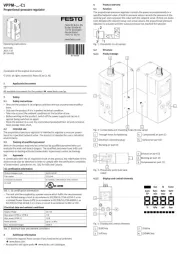
2 Augustus 2025
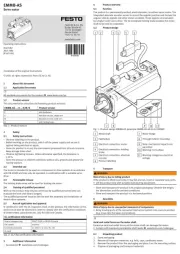
1 Augustus 2025
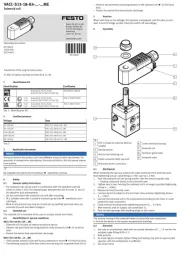
1 Augustus 2025
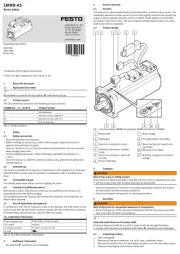
1 Augustus 2025
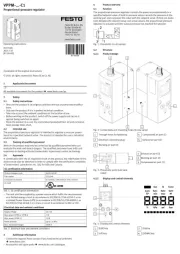
1 Augustus 2025
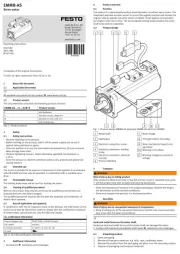
1 Augustus 2025
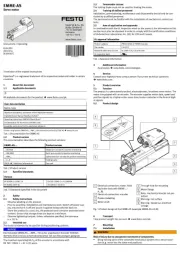
1 Augustus 2025
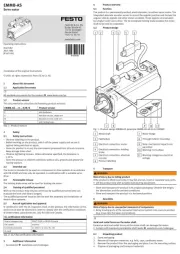
1 Augustus 2025
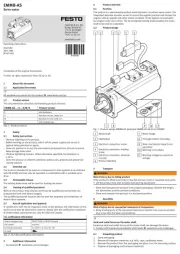
1 Augustus 2025
Handleiding Niet gecategoriseerd
- Ritter
- Corel
- Blue
- Club 3D
- Quadro
- Carson
- Dot Line
- BISWIND
- RME
- AV:link
- Sauber
- Savage Bros.
- Intertechno
- Leef
- Nexxt
Nieuwste handleidingen voor Niet gecategoriseerd
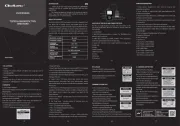
13 September 2025
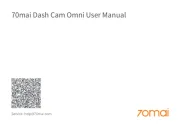
13 September 2025

13 September 2025
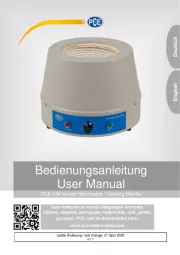
13 September 2025

13 September 2025
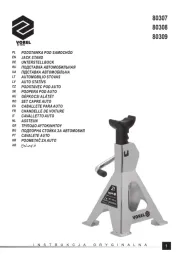
13 September 2025
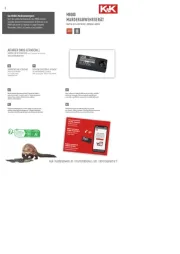
13 September 2025
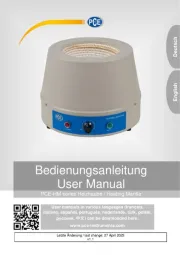
13 September 2025

13 September 2025
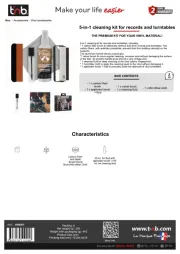
13 September 2025